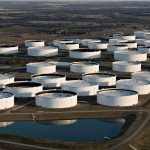Every Thursday, EnerCom’s Oil & Gas 360® will deliver media stories, company updates, and research commentary covering the natural gas spectrum. The theme for this week: Demand Forces: Coal to Gas Switching, and LNG Export Plans.
NATURAL GAS INVENTORY (Week Ended 9/21/12)
Current: 3,576 Bcf
Actual Injection/(Withdrawal): 80 Bcf
Economist Average Estimate: 77 Bcf
Previous: 3,496 Bcf
Click here for the chart with five year averages.
NATURAL GAS IN THE MEDIA
*Potential U.S. LNG exports under fire – UPI
Democrats in the U.S. House of Representatives expressed concern about the effects of liquefied natural gas exports in a letter to a Cabinet official. House Democrats, led by Reps. Jared Polis, D-Colo., and Maurice Hinchey, D-N.Y., wrote a letter to Energy Secretary Steven Chu calling for an environmental review of potential LNG exports. “We are concerned that exporting more LNG would lead to greater hydraulic fracturing, or fracking, activity thus threatening the health of local residents and jobs,” the Platts news service quoted the letter as saying. They said LNG exports could equate to about 30 percent of the national gas production and expressed concern that Chu hasn’t announced plans for an environmental review. – Read More
*Fracking Makes U.S. Surprise Energy Power – Bloomberg
Asian demand for natural gas has risen so sharply in recent years that Alaska wants to build a $50 billion pipeline and export terminal to move its stranded supply offshore. Exxon Mobil Corp., BP Plc and ConocoPhillips will deliver plans for such a project to Alaska Governor Sean Parnell by the end of this month. Alaska has the only operating liquid natural gas (LNG) export plant in the United States. It’s an aging facility, capable of processing less than 10 percent of the volume of a new 3 billion cubic-feet-a-day terminal. The state’s hunger for revenues from its conventional gas is part of a larger unsolved question that the U.S. will have to tackle in the next few years: What will the nation do with its newfound abundance of natural gas, mostly from unconventional sources? The question lurks just under the surface of the national energy conversation, which vacillates between exuberance that shale gas exists at all and fear that the method of extracting it — fracking — is polluting people’s water. The high-pitched debates around fracking largely obscure another player: the rest of the world. It wants less expensive natural gas. – Read More
[sam_ad id=”32″ codes=”true”]
*Former Sunoco refinery in Marcus Hook will process Marcellus Shale products – The Philadelphia Inquirer
Sunoco Inc. announced Wednesday that its shuttered Marcus Hook refinery would be reborn as a facility to process Marcellus Shale natural-gas products, fueling new construction and traffic through the Delaware River port. Sunoco’s pipeline subsidiary, Sunoco Logistics Partners L.P., is moving forward with a plan to transport high-value propane and ethane by pipeline from Western Pennsylvania to Marcus Hook, where the materials will be processed in a new plant and shipped by sea to domestic and export markets. State officials hailed the project — which Sunoco calls Mariner East — as a boost for Pennsylvania’s Marcellus Shale industry by connecting the areas producing natural gas in Western Pennsylvania to markets linked to Philadelphia. “I have long held that the Marcellus Shale is an important resource that over time would benefit the entire commonwealth,” Gov. Corbett said in a statement. – Read More
*Natural Gas Pipelines to Expand U.S. Supply Glut: Energy Markets – Bloomberg
Natural gas pipelines coming into service by year end may boost deliveries from the Marcellus shale deposit in the U.S. Northeast by 30 percent, extending a supply glut that helped send prices to decade lows. As much as 2 billion cubic feet of gas a day are set to flow from the lines in Pennsylvania, Ohio and West Virginia, bound for markets along the Eastern Seaboard, based on government and pipeline-company projections. About 1,000 Marcellus shale wells sit uncompleted, mainly because of a lack of pipeline infrastructure, according to the Energy Department. Gas prices have dropped 60 percent since 2007 as producers used techniques such as hydraulic fracturing, or fracking, to reach supplies trapped deep in tight layers of shale. Gas futures tumbled to $1.902 per million British thermal units in April, the lowest price since 2002, as stockpiles ballooned during a mild winter and record U.S. production. – Read More
*Coal vs. natural gas: It’s complicated – Houston Chronicle
The glut of natural gas unleashed by hydraulic fracturing – and the resulting low prices – make it seem like a no-brainer: Ditch coal-fired electric plants, with all their baggage about air pollution and water consumption, and switch to natural gas. Trends over the past year suggest that’s starting to happen nationally, as natural gas has overtaken coal for generating electricity. Use of coal to generate electricity was down almost 18 percent for the first seven months of 2012, compared with the same period in 2011, according to the U.S. Energy Information Administration. Natural gas use was up by 30 percent. In Texas, the proportion of electricity generated with coal dropped 8 percentage points so far in 2012. But with a new Central Texas coal plant scheduled to begin operations next spring, coal-generated electricity is likely to remain a substantial part of the state’s grid for years to come. – Read More
*Natural Gas Futures Climb to Two-Week High on Inventory Outlook – Bloomberg
Natural gas futures advanced in New York to the highest level in two weeks as concern eased that supplies would test storage limits before demand picks up with colder weather. Gas rose 3.4 percent as the October contract expired. U.S. stockpiles gained 77 billion cubic feet last week, based on the median of 20 analyst estimates compiled by Bloomberg. Supplies totaled 3.496 trillion cubic feet as of Sept. 14, below the Energy Department’s estimated capacity of 4.239 trillion. The agency’s weekly supply report is scheduled for release tomorrow. “The market continues to find some buying from the end-of- the-month expiration trading,” said Gene McGillian, an analyst and broker at Tradition Energy in Stamford, Connecticut. “Without worries that we are going to see a flood of gas in the physical market if storage is full, the market can look a little more toward the winter heating season.” Natural gas for October delivery jumped 9.9 cents to $3.023 per million British thermal on the New York Mercantile Exchange, the first settlement above $3 since Sept. 13 and the biggest increase since Sept. 11. The futures have climbed 7 percent since June, heading for a second straight quarterly gain. – Read More
*Marathon Oil Seeks to Exit Marcellus Shale –Sources – Fox Business
Marathon Oil Corp. (MRO) is putting its natural gas-rich acreage in the Marcellus Shale formation up for sale as it trims noncore assets, people familiar with the situation said. Marathon Oil is putting about 80,000 acres in West Virginia and Pennsylvania up for sale because the company doesn’t consider them central to its growth plans, a person familiar with the company’s plans said Wednesday. The company could realize up to $1,000 an acre, the person estimated, adding that a specific price hasn’t been set yet. Another person familiar with the company’s thinking said that the move is part of Marathon’s re-evaluation of its portfolio in the wake of last year’s spin-off of its refining division. Marathon Oil wouldn’t comment “on rumors and speculation in the market,” company spokeswoman Lee Warren said. The Marcellus Shale, a vast shale rock formation underlying the northeastern U.S., has become a major source of natural gas because after companies began applying hydraulic fracturing there. The region could have up to 262 trillion cubic feet of technically recoverable natural gas, according to a 2009 Department of Energy study. – Read More
*GE Secures $1.2bn in New Orders for ‘Most Efficient’ Natural Gas Power Plant Technology – Environmental Leader
GE has announced a natural gas power plant, the FlexEfficiency 60, that it says avoids up to 56,000 metric tons of carbon emissions per year relative to existing technology. GE also said it has secured about $1.2 billion in new orders for FlexEfficiency 60 technology for projects in the US, Saudi Arabia and Japan. The FlexEfficiency 60 combined-cycle power plant, which GE calls the “most efficient power plant of its kind,” has the capacity to reach greater than 61 percent thermal efficiency. Like its 50-hertz counterpart, the FlexEfficiency 50 plant that GE introduced in 2011, the FlexEfficiency 60 plant rapidly increases or decreases its power output in response to fluctuations in wind and solar power. This enables power companies to integrate more renewable resources onto the power grid, and saves them money and fuel, according to GE. GE says if just one equivalent-size coal plant was replaced with the ecomagination-qualified FlexEfficiency 60 plant, the offset carbon emissions would be 2.6 million metric tons per year. FlexEfficiency 60 technology will be manufactured and tested at a gas turbine manufacturing facility in Greenville, S.C. – Read More
*Qatar Natural Gas Firm to Send More Fuel to Japan – AP
Qatari state-backed natural gas producer Qatargas says it has signed a long-term supply deal with a Japanese power company as the Asian nation increasingly relies on fossil fuels after a nuclear meltdown last year. Qatargas said Wednesday the deal with Kansai Electric Power Company covers shipments of half a million tons of liquefied natural gas annually for 15 years, beginning next year. Financial details were not disclosed. Qatar is the largest producer of LNG. KEPCO will get its gas from the Gulf nation’s Qatargas 3 division, in which ConocoPhilips owns a 30 percent stake. Japan is the top importer of LNG. Demand for the oil and gas has soared in Japan because the bulk of its nuclear plants remain offline after a disaster at the Fukushima Dai-ichi nuclear plant following a devastating earthquake. – Read More
RESEARCH COMMENTARY
*Baird Equity Research (9.28.12)
July EIA 914 onshore production increased 0.3% M/M; Lower 48 +0.4% M/M. This is slightly below our adjusted forecast of 0.6% onshore production growth and 0.8% Lower 48 growth. Production increases were New Mexico, Marcellus/Other, Texas, and GoM; partially offset by Wyoming. We forecast August production to decline 0.3-0.9% M/M. Strong gas price action recently highlights increased investor confidence in current storage dynamics and generally stable supply coupled with seasonal tailwinds.
July onshore production increased 0.3% M/M. The data shows onshore production increasing by 0.2 bcf/d, or 0.3% M/M, to 68.5 bcf/d. June onshore production was revised down to 68.3 from 68.4 bcf/d previously. Our proprietary model was forecasting 68.7 bcf/d, +0.6% M/M, adjusted for June revisions. New Mexico drove the increase, driven by new wells and maintenance completion; Texas and Marcellus/Other also contributing.
July Lower 48 production increased 0.4% M/M. EIA data shows July Lower 48 production increased 0.4% M/M to 72.6 bcf/d, with delta versus onshore an increase in GoM production. June data was revised down to 72.3 bcf/d from 72.4 bcf/d previously. Our proprietary model was forecasting 72.9 bcf/d, +0.8% M/M, adjusted for June revisions.
August production forecast to decline modestly -0.3 to -0.9% M/M. We project August onshore production to decrease to 68.3 bcf/d, -0.3% M/M. We also forecast August Lower 48 production to decrease 0.9% M/M to 71.9 bcf/d. The bulk of the decline is attributed to Gulf Coast and offshore GoM due to hurricane shut-ins. July and August production in aggregate is essentially flat. Despite the decrease in gas rig count, we do not anticipate US onshore production to turn over in the near term.
Production trends by region. Onshore production increases were New Mexico +0.09 bcf/d, Texas +0.09 bcf/d, and Other/Marcellus +0.08 bcf/d. Decline was Wyoming -0.07 bcf/d. Offshore GoM increased 0.07 bcf/d.
Storage/tightness still the focus, but gas sentiment improving. With only five reports remaining until the pivotal end of October peak storage number, investors remain amply focused on weekly storage reports and implied market tightness, though seemingly more content with current storage dynamics (likely enter winter with ~4Tcf (+/-) in storage). Seasonal tailwinds (rolling to November front month) also supportive of strong gas price action, with the front month currently trading at ~$3.30/MMBtu. We are cautiously optimistic on natural gas dynamics heading into the winter months, with the concerns around testing storage capacity abating as we progress through the fall shoulder season.
*Raymond James Equity Research (9.27.12)
El Nino…La Nina…all we want is just a normal winter. With the October contract rolling off and natural gas prices trading more than $0.20 cents above the $3 level, are we set for a head fake in natural gas prices? With 7 more weeks left of injections, we expect coal-to-gas switching to subside, but believe overall power demand will remain strong enough to eat away at the y/y surplus and avoid testing max storage (4.0-4.1 Tcf); however that will only happen if we get a normal winter heating season. By our math, with 3,576 Bcf currently in storage and likely another 7 weeks of injections remaining, using weather adjusted injections of 484 Bcf, we need to run at least 3.25 Bcf/day tighter y/y in order to reach 3.9 Tcf in storage. With varying weather forecasts for this coming winter and 2013, we believe natural gas prices have to remain range bound over the near term ($2.50 – $3.00 range), to continue to incentivize coal-to-gas switching. Last month’s slow down in production was just a short blip as production has climbed back to near record levels. With that said, it appears that the market is in better balance, but these next few weeks of injections could tell us if the rebound in natural gas prices was more of a head fake than an indication that the market will remain at these tight levels through the winter.
*Tudor Pickering Holt & Co (9.27.12)
Gas storage ($3.2/mcf). Bloomberg consensus looking for 77bcf injection vs. seasonal norm ~70bcf on slightly milder than normal mid-September weather. Current storage of 3,496bcf is 437bcf (+14%) above 10-yr norms and 322bcf (+10%) above y-ago.
*Tudor Pickering Holt & Co. (9.27.12)
NGL Market Update ($0.88/gal; 40% WTI; 33% Brent)
East Coast Joins the NGL Export Party: Prediction from April NGL Report is vindicated as SXL announces Mariner East project to move propane and ethane out of SUN’s former refining site in Marcus Hook, PA. Propane exports are a long-term no-brainer as US propane prices more than 50% below NW European pricing today. Although the Northeast remains a net importer of propane in the wintertime (and therefore is often at premium to other US prices), our April NGL Report predicted Northeast propane going long by 2015, so given proximity to Europe, we saw propane exports as inevitable. On the other hand, we were skeptics on ethane exports due to complete lack of ethane-capable petchem facilities in high-cost areas like Europe and Asia. RRC (as anchor shipper on the project) proved us wrong and negotiated a long-term ethane supply deal with INEOS for 10 MBPD (ramps to 20 MBPD over time). We estimate that RRC will receive $0.50/gal, or 66% higher than current Belvieu prices. At current ethylene prices, INEOS could see a margin uplift of $60mm per each 10 MBPD of ethane vs. cracking naphtha, even after estimated transport costs. So the obvious question: why isn’t everyone swimming over to PA to get some of that ethane? The integrated nature of many European refining/petchem facilities means that ethane can cause integrated derivative plants to become dependent on high-cost 3rd party feedstock supply.
NGL Demand – Moving to the Right: At a recent NGL conference, we were struck by how the bullish views of consultants and certain company representatives contrasted with anxiety about pricing and excitement on the part of NGL consumers. Project development guys from chemical and integrated companies (some talking their book, some talking against) agreed that major petrochemical projects would likely miss budgets and startup dates, and that demand for E&C services would eventually present a bottleneck as the industry seeks to build 5+ crackers in the US, a country that hadn’t built a new cracker in a decade. E&Cs poised to benefit from cracker build-out include FLR, KBR & CBI (order of preference) while JEC likely participates in ethylene derivative EPC/m. A waterborne LPG trader from a major downstream company noted that substantial propane export arbitrage opportunities could be locked in for years into the future in liquid trading markets, reflecting expectations of persistent NGL (largely propane/butane) oversupply in the US. We think that this persistent arb opportunity will lead to more propane export capacity getting built over time, eventually tightening the propane arb beyond 2015.
Ethane – looking like gas circa 2009: 63% drop since January has been bad, but anemic 9% price bounce in the face of ~10% production curtailments is probably worse (+9% since June lows vs. WTI +17%, gas +30%). ~150 MBPD is already being left in Rockies/Midcon/Permian gas stream due to higher netback from selling less ethane and more gas in Rockies/Midcon, and physical capacity limits in Permian. Worse news: we haven’t seen much of supply side hit the market yet. Don’t be headfaked by EIA data showing falling ethane production. Ethane is being rejected for economic reasons. -11% YTD production growth obscures approximate 5% growth in ethane extraction potential, which will hang over market once massive infrastructure build in 2013 removes bottlenecks. Pipes and fracs will increase ethane supply to Belvieu hub by 300+ MBPD in 2013-14, well before major demand expansions (US base production of 1.1 MMBPD).
Propane – will planned exports be enough? As US demand for propane falls (Northeast heating market switching to gas, long-term petchem switching to ethane), producers will increasingly rely on exports to balance US market. Currently, the arb between Belvieu and the globe stands at a massive $1/gal vs. a US propane price of $0.88 (vs. ~$0.20/gal shipping cost). With such a huge opportunity, propane dock expansions are currently underway, with TRGP and EPD already working on projects that will double total US export capacity to ~350 MBPD. Our model says that with normal winters, supply/demand will remain loose even as those facilities come online. Outside the Gulf, SUN and MWE will go through with a planned Marcellus propane export facility at the idled Marcus Hook refinery by 2015. By 2016, ~90 MBPD of propane will be consumed to produce propylene. Consensus is growing that US will be short propylene as ethylene crackers move to ethane, leading to construction of several PDH units to convert propane into propylene. Each facility can consume ~30 MBPD (total market 1.2 MMBPD currently), with 3 proposed for 2015 (DOW, EPD, WMB) and potentially 1 more in 2018 (DOW).
Midcon ethane weakens: In our September midstream monthly, we took a look at the ethane rally at Conway. We made it clear that despite appearances, the ethane market was not improving, and the dead-cat bounce from 1.5 cents per gallon to 25c by late August reflected that fears about Conway storage overflowing were subsiding. As storage overflow became unlikely, the relief rally began, but ethane at Conway traded at a premium to gas value for all of 7 days before falling below gas value again. Conway is still bottlenecked and ethane rejection remains a part of daily life in the Midcon and Rockies. Ultimately, we think Conway gets better vs. Belvieu as pipes come online and the “haves” at Belvieu are forced to share their market with the “have nots” in Conway. The US is becoming one big Belvieu suburb, and as it gets easier for NGLs to commute into Belvieu, the Belvieu premium over Conway will narrow (as Conway ethane gains and Belvieu ethane falls).
*UBS Investment Research (9.24.12)
Forecasting a 70-80 Bcf injection to be reported this week. We expect the EIA to report a 70-80 Bcf injection, below 2011’s 111 Bcf injection but in line with the 5-year average of a 75 Bcf injection. We estimate inventories increased to 3,571 Bcf, narrowing the surplus vs. 2011 to 259 Bcf but leaving the surplus vs. the 5-year average unchanged at 290 Bcf.
Weather cooler last week vs. 2011 and the 5-year average. Last week’s weather was 6% and 33% cooler than the comparable year ago week and 5-year average, respectively. Since May, weather has been 3% cooler than 2011 but 6% warmer than the 5-year average. Roughly 8% of CDDs remain ahead of us.
Forecasting storage to peak this Fall at 3.9 Tcf. We estimate the weather-adjusted S/D balance loosened ~1 Bcfd WoW for the week ending 9/14. We estimate the weather adjusted S/D balance has been ~3.4 Bcfd undersupplied vs. the 5-year average and ~4.8 Bcfd undersupplied vs. the year ago over the last month due to significantly larger price induced fuel switching from coal to natural gas boosting demand. We expect storage to build to a record peak of 3.9 Tcf on October 31 (0.22 Tcf above the 5 year average).
E&Ps are discounting $4.55/Mcf long-term, normalized natural gas prices. This compares to the 2012 & long-dated (2016) futures curves of $2.70/MMBtu and $4.43/MMBtu. Our top E&P picks are: APC, NBL, EOG, OXY and MRO.
*Raymond James Equity Research (last week 9.21.12)
Atlas Shrugged – Can coal again shoulder the burden of weaker demand in an oversupplied gas market during shoulder season?
A combination of record summer heat and increased levels of coal-to-gas switching has tightened the oversupplied gas market and kept prices afloat (if you can call above $2/Mcf “afloat”) over the course of the injection season. The y/y surplus continues to shrink as we enter shoulder season, but there is essentially zero chance that we get back down to 2011 storage levels at the current run rate. That being said, just “how full” we will get is the next question. As always, weather will be the biggest wild card in this equation. Another mild winter could spell disaster for the coal and gas markets which are already at decade lows. Stay tuned to the weather forecasts! By our math, with 3,496 Bcf currently in storage and likely another eight weeks of injections remaining, we use last year’s total injections of 685 Bcf and assume that we run at least 3.25 Bcf/day tighter y/y in order to avoid reaching our target storage of 3.9 Tcf. In order to do this however, weather will need to cooperate and natural gas prices will ultimately be range-bound over the near term (six months) in the $2.50-3.00 range, given that this is our estimated economic threshold to switch out west. This is evidenced by the recent decline from nearly $3.20/Mcf (hurricane-related) back to the $2.80/Mcf level currently. With production climbing back to near-record levels, the uncertainty lies with weather, and assuming temperatures are more normal than last year we should avoid hitting maximum capacity.







